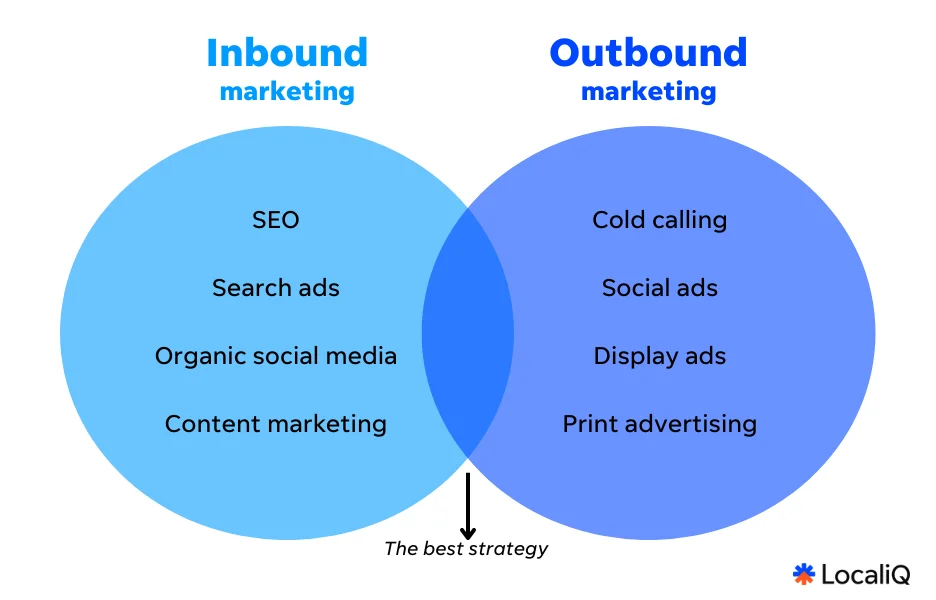What Is Outbound Marketing?
Outbound marketing refers to any kind of marketing where a company initiates the conversation and sends its message out to an audience. Outbound marketing examples include more traditional forms of marketing and advertising such as TV commercials, radio ads, print advertisements (newspaper ads, magazine ads, flyers, brochures, catalogs, etc.), tradeshows, outbound sales calls (AKA “cold calls”), and email spam.

Outbound marketing versus inbound marketing
Outbound marketing is the opposite of inbound marketing, where the customers find you when they need you. Examples of inbound marketing include content marketing, blogging, SEO, and opt-in email marketing. In addition, paid search advertising is considered inbound marketing, because your ads only appear when people are searching for products or services that you offer.
Outbound marketing is generally harder to track and less profitable than inbound marketing, yet ironically, organizations still spend as much as 90% of their marketing budgets on outbound marketing.
Organizations looking to improve their sales and return on marketing spend would be well advised to re-allocate an increasing percentage of their marketing budget on inbound marketing techniques.
What’s the problem with outbound marketing?
Outbound marketing constitutes the majority of marketing budgets for many businesses. It’s been around for ages and some even consider it a cost of doing business. Outbound marketing, though, presents a lot of difficulties, and tradition and past mistakes should never get in the way of adapting to changing marketing trends. Problems with outbound marketing include:
- Difficulty in tracking return on investment (ROI)
- Increasing blocking techniques (Do not call list, Spam filters, TiVo, etc)
- High cost, low yield.
CRM Daily reports, “nearly half of the companies that implement inbound marketing efforts see a 25 percent greater return on investment (ROI) on those programs than companies that do not. The survey found that inbound marketing channels can deliver up to 30 times the campaign conversion rate of traditional outbound direct-mail campaigns.” Inbound marketing is easier to track, has a higher ROI, and lower overall costs than outbound marketing. Your next step, of course, is to cut costs and increase conversions by shifting from outbound marketing to inbound marketing.
Inbound marketing and search engine marketing
One of the most effective ways to capitalize on the benefits of inbound marketing is with search engine marketing activities. Search marketing is unique in that your customers start the conversation by searching on a topic – you as the advertiser have the ability to insert yourself into the conversation. The idea is to create ads and Web pages that will show up when someone searches for something relevant to your business, making it easier for customers to find you. Someone who searches for your product or service is a warm lead, and if you aren’t there to catch him, a competitor likely will.
Consider the last time you made a purchase. Where did you go? Did you look for ads in the Yellow Pages? Attend a trade show? Search for the product online? Most likely, you answered with the latter, and so did your customers.
To get started with inbound Web marketing, set up Pay-Per-Click (PPC) campaigns on Google AdWords and author relevant content for Search Engine Optimization (SEO). The more content on your website, the more reason for someone to land there, and the easier it will be for potential customers to find you.
Making the shift: Moving from outbound marketing to inbound
Initiating PPC campaigns and SEO efforts may sound like daunting tasks, but they don’t have to be. Use the following as a guide to success with search engine marketing. You’ll want to:
- Start with Keyword Research: Use a free keyword tool to build a list of keywords relevant to your business, so you can start targeting them in your search campaigns.
- Create Campaigns on Google Ads: If you haven’t already, start with a PPC campaign on Google, the web’s most commonly used search engine, to begin experimenting with keywords and driving new traffic to your website. Be sure to include your keywords in the ad copy.
- Optimize Google Ads Campaigns: Sort your keyword groups by relevance for the best Quality Score.
Find out what optimizations you can make to your account with our Free Google Ads Performance Grader
- Continue Keyword Research: Set up a system to record search queries that bring people to your site so you have a better understanding what they’re looking for and how you can help. Continuously build your keyword list with relevant, specific keywords for your long tail outreach.
- Generate Relevant Content: Use keyword data to understand market behavior and write interesting, compelling content about these subjects on your website for search engine optimization. The best part about this is that once you start showing up in organic results, clicks are free!
- Repeat, Prioritize and Optimize: For your search campaign to perform at its best, these steps should be repeated periodically. Learn more about how to make search advertising work for you at our free online learning resource, PPC University.
Just as Rome wasn’t built in a day, moving to an inbound marketing system is an iterative learning process, not a get-rich-quick scheme.
Improve your ROI and discover new customers with search engine marketing!
